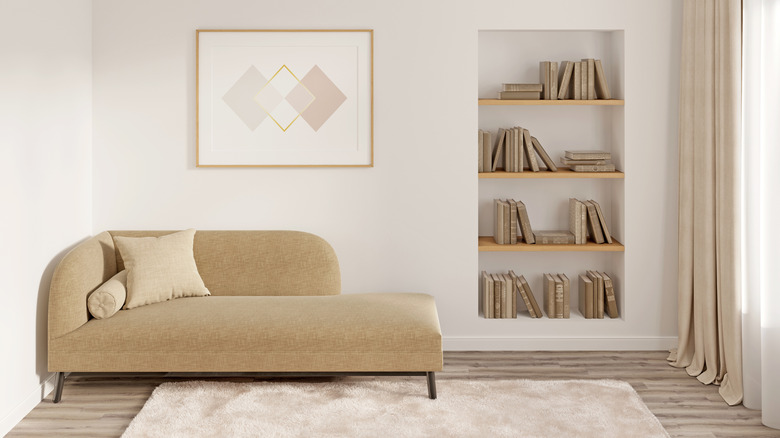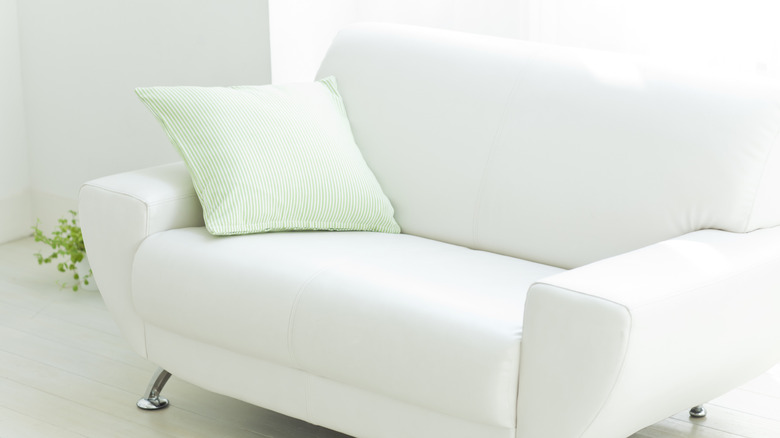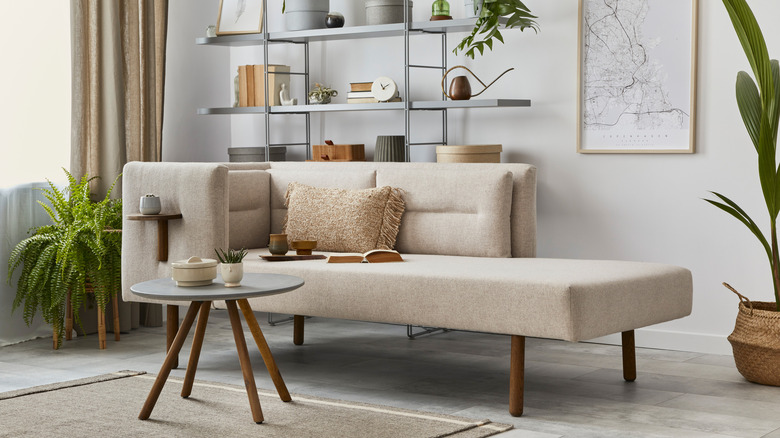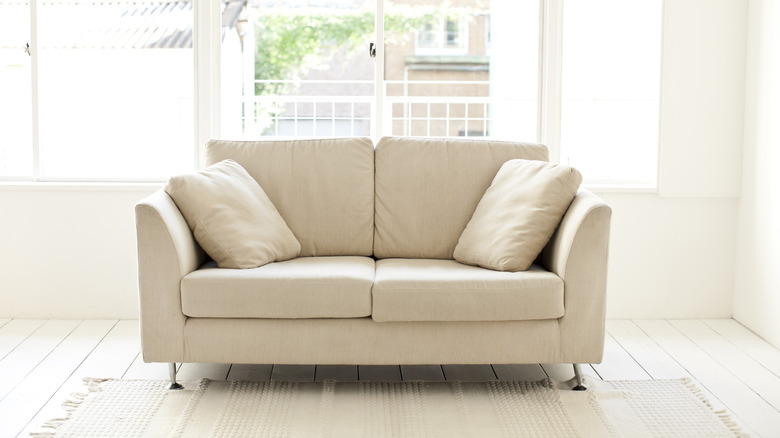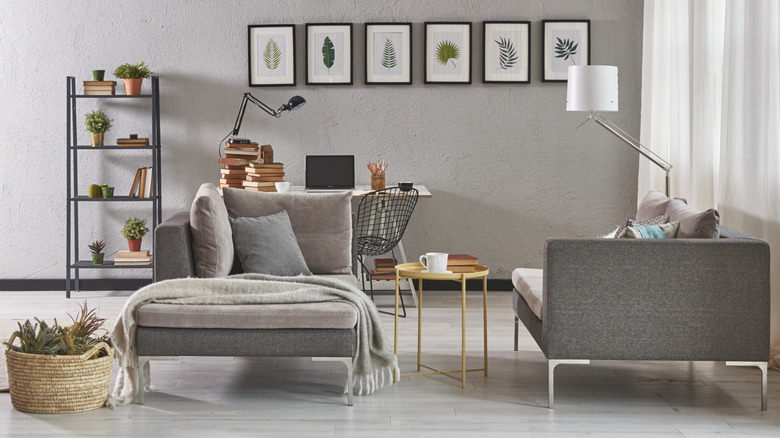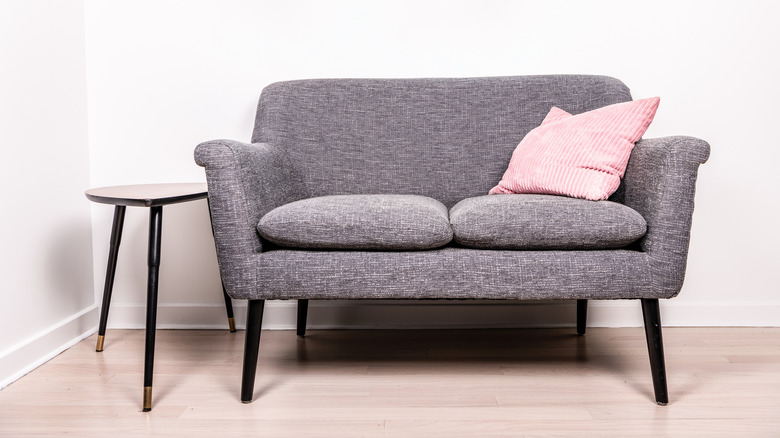Loveseat Vs. Chaise: What's The Difference?
When furnishing a living room, media room, or other sitting area in your home, you'll be faced with the task of choosing a chair or sofa for both yourself and guests to comfortably sit and lounge in. With so many seating options, this decision can become overwhelming. Many people in smaller spaces or those wanting to create a more intimate feel may be drawn to two furniture pieces — chaise lounges and loveseats.
Chaises and loveseats are more intimate options over a three-seater or sectional sofa, but they're larger and cozier than a simple armchair. Both of the seating options are actually considered chairs with unique designs. While both of them are ideal for smaller spaces or for seating smaller amounts of people, they have a few distinguishing features you should consider before purchasing. As Furniture.com notes, both chairs can be sat on and slept on, but chaise lounges tend to only fit one person, whereas a loveseat is made to fit two. There are plenty more differences between the two, though.
How does the appearance differ?
While many people think of loveseats as simply being a two-seater couch, they're actually large, wide chairs that can fit two people, according to Home Stratosphere. In fact, historical loveseats in the 17th century used to be essentially made of two chairs facing each other in an "S" shape. The nickname comes from the chair's popularity among people courting each other, as the seating provided an intimate place for conservation while still being appropriately distanced. While the loveseat has had many iterations throughout the centuries, this category of chair now encapsulates any piece of furniture made for two people to sit on, including couches and outdoor benches.
Chaise lounges are chairs that can be found in mainly two styles — a long, loveseat-shaped chair with a back that curves upward with only one armrest, or in the style of an armchair but longer, giving you room to put your feet up, per Home Stratosphere. The former tends to be somewhat dramatic and have a fancier feel. The latter is more modern in shape and design and is often found attached to a sectional couch. Both are ideal for one person to relax or sleep.
What are the differences in cost?
When it comes to the price difference between chaise lounges and loveseats, there isn't one definitive answer. Antique varieties of these chairs tend to be more expensive, although the price when purchasing new will vary based on the materials used and quality of the piece. If you want the look of a historical chaise lounge, you may have to shell out a bit of money for an antique. For example, this antique chaise lounge from 1stDibs costs $9,700. Meanwhile, a new simple fabric chaise, like this one from Wayfair, can start at around $370.
Antique loveseats are also popular, and a good-quality chair can cost around $1,000 on average. As Home Furniture DIY notes, new loveseats can range anywhere from $320 on the low end to $1,400 on the high end. Factors like size, weight, textiles, materials, and design can dramatically raise or lower these prices. While some loveseats are simple two-seaters made of fabric, adding upgrades like recliners or switching out the fabric for real leather starts to increase the price.
Pros and cons of loveseats
While there are plenty of benefits to having a loveseat in your home, there are a few drawbacks to consider before making a costly purchase. One of the biggest pros of loveseats is that they comfortably fit in most small spaces, says Apartment List. While people living in tiny homes, studio apartments, and other small spaces may feel inclined towards a daybed or simply using their bed as a couch alternative, loveseats are often small enough to add to the foot of a bed and provide more seating options. Loveseats also often come in matching sets with couches and armchairs, providing more matching decorating options.
That being said, loveseats are still quite small, especially when compared to larger sofas. While they can comfortably seat two people, there isn't much room for you to put your feet up or lounge if someone else is sitting with you. If you only have a loveseat and are having a guest over, it may prove to be uncomfortable or even impossible for them to sleep on, too.
Pros and cons of chaise lounges
Just as with loveseats, chaise lounges have both benefits and drawbacks that you should consider before making a final decision on your next furniture purchase. One major pro to chaise lounges is that sideways facing chairs look and can function just like a loveseat, notes Homethangs.com. However, the lack of an armrest on one end makes them more comfortable to lounge and sleep on. Forward-facing chaise lounges are even more comfortable for lounging. Chaise lounges also tend to be lower to the ground and can help preserve the view out of a large window in a room, Houzz points out.
While forward-facing chaise lounges are certainly lounge-ready, they aren't always great to sit on, lacking the versatility of a loveseat or even an armchair. They may take up more space than they save, blocking the walking path in a room or awkwardly sticking out where they shouldn't. And while there are certainly more modern designs on the market, they tend to have a very specific look and aesthetic that may not blend with the rest of your furniture.
Recommended uses of each
Loveseats and chaise lounges have a few similar uses, especially sideways facing chaise lounges that can function as loveseats. That being said, there are a few circumstances where you may want to choose one over the other, whether due to space concerns, functionality, or use.
Houzz explains a variety of potential uses for chaise lounges over loveseats. As previously mentioned, chaise lounges are usually lower to the ground and can help amplify views. Similarly, their lower frame can help make a room look more natural, flowing, and seamless. They can also provide precious walking space in small or narrow rooms that would be lost with a couch. Lastly, they tend to look cozier than loveseats and are ideal in bedrooms, lounge rooms, media rooms, or guest rooms.
On the flip side, loveseats have a more traditional silhouette than most chaise lounges, which may fit your personal style more. They also tend to come in matching sets with other furniture pieces, whereas chaise lounges are more of an accent piece. Loveseats have the additional advantage of seating more people than a forward-facing chaise lounge. Ultimately, though, the decision comes down to personal preference.
